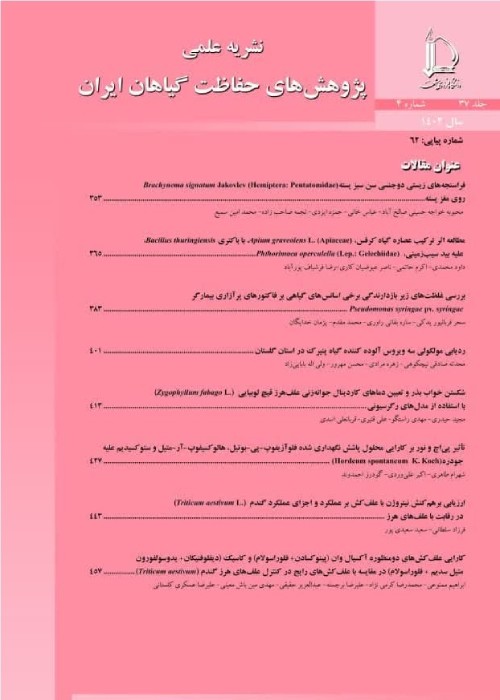Mortality Rate of Frankliniella occidentalis Under Recommended Concentration of Some Insecticides and the Amount of Its Attraction to Colored Sticky Traps in Apple Orchard
Author(s):
Article Type:
Research/Original Article (دارای رتبه معتبر)
Abstract:
Introduction
Western flower thrips, Frankliniella occidentalis (Pergande) is a serious pest of fruit crops in flowering stage worldwide. Many researches have been studied different methods of western flower thrips control. Two control methods including pesticide application and the use of colored sticky traps are commonly used by farmers due to the ease of use and low running costs. Chemical control is known as the main tool in controlling of this pest. In recent decades, mixing several kinds of pesticides by farmers has been become common strategy which seems to be due to their synergistic effects and decreasing of pest resistance one. The current study was done to detect the best color sticky trap in monitoring and to determine the most effective pesticide in controlling western flower thrips.Materials And Methods
In the current study, the pest attraction rate by 3 sticky color traps (Blue, Yellow, White) and efficacy of five pesticides were investigated against western flower thrips in two separately randomized complete block design in the apple orchard around Shiraz city. The treatments included: deltametrin imidacloprid, acetamiprid, antifeedant, azadirachtin and oxydemeton methyl. Mortality percent of insects in different treatments was calculated using the Henderson-Tilton formula. Before conducting the experiment, trees was not treated by any pesticides for one year. Each trap was hung in the middle of the trees´ canopy at about 1.5 meter height from the ground. Sticky cards (10 x 25 cm) were visited weekly to record the number of the captured western flower thrips. Each trap was replaced with new one weekly. Number of western flower thrips was analyzed through one-way analysis of variance (ANOVA) using the SPSS version 9. The significant differences among means were compared using the Duncan's multiple range test at 95% confidence interval whenever treatment effects were significant.Results And Discussion
Analysis of variance showed that there were significant differences among treatments after 14 days post-treatment (F5, 10 = 6.51, P = 0.006). Mean comparisons showed that treatments deltametrin imidacloprid, acetamiprid and antifeedant had significant difference with control. Pesticide efficacies based on Henderson-Tilton formula at 14 days post-treatment showed that acetamiprid provided the best control (83.3%) of F. occidentalis, followed by deltametrin imidacloprid (77.7%) and antifeedant (70.1%). Effectiveness of acetamiprid, which is a systemic pesticide and belongs to neonicotinoids, against a wide range of insect pests has been reported by many researchers. The treatment oxydemeton methyl caused low mortality (less than 30%) in F. occidentalis. The reason of that may be related to resistance of this insect to oxydemeton methyl. This pesticide is older than other tested compounds and has been used by farmers against fruit pests from long time ago. Further studies are needed to confirm these findings like bioassay of this pesticide. In addition, some researchers have shown that inappropriate application of chemical compounds resulted in high level and widespread resistance of thrips to chemicals. Results of color traps showed that blue traps attracted significantly more thrips than other colors in the all sampling dates. On average, the blue, yellow and white traps captured 34.31 ± 13.85, 12.56 ± 4.78 and 4.87 ± 1.83 thrips respectively. In general, there are many studies have been conducted to determine the effect of color traps on thrips. Some studies have reported that thrips are attracted to blue, while the others have reported that yellow is more attractive for them. There are evidences that F. schultzei is also caught by red color. With regard to color preference of western flower thrips, there are many disagreements among researchers. Different researchers have stated different reasons for these contradictions that the most important are the availability of food sources, thrips density, environmental conditions and the duration time of the experiment carrying out.Conclusion
The results of the present study indicated that a remarkable ability of blue traps in catching of the western flower thrip. In addition, results showed that acetamiprid, deltametrin imidacloprid and antifeedant could considerably reduce the population density of F. occidentalis. Although the pesticides acetamiprid, deltametrin and imidacloprid have been recommended in IPM programs, in organic farming, it is approved that application of pesticides are much more limited. It seems that antifeedant is environment-friendly and can be recommended in organic farming. However, more research is needed to explore the impact of this compound on other agricultural systems. In conclusion, blue sticky color and deltametrin imidacloprid, acetamiprid and antifeedant could be useful in IPM planes against western flower thrips.Keywords:
Language:
Persian
Published:
Journal of plant protection, Volume:31 Issue: 4, 2018
Pages:
645 to 652
magiran.com/p1795084
دانلود و مطالعه متن این مقاله با یکی از روشهای زیر امکان پذیر است:
اشتراک شخصی
با عضویت و پرداخت آنلاین حق اشتراک یکساله به مبلغ 1,390,000ريال میتوانید 70 عنوان مطلب دانلود کنید!
اشتراک سازمانی
به کتابخانه دانشگاه یا محل کار خود پیشنهاد کنید تا اشتراک سازمانی این پایگاه را برای دسترسی نامحدود همه کاربران به متن مطالب تهیه نمایند!
توجه!
- حق عضویت دریافتی صرف حمایت از نشریات عضو و نگهداری، تکمیل و توسعه مگیران میشود.
- پرداخت حق اشتراک و دانلود مقالات اجازه بازنشر آن در سایر رسانههای چاپی و دیجیتال را به کاربر نمیدهد.
In order to view content subscription is required
Personal subscription
Subscribe magiran.com for 70 € euros via PayPal and download 70 articles during a year.
Organization subscription
Please contact us to subscribe your university or library for unlimited access!


